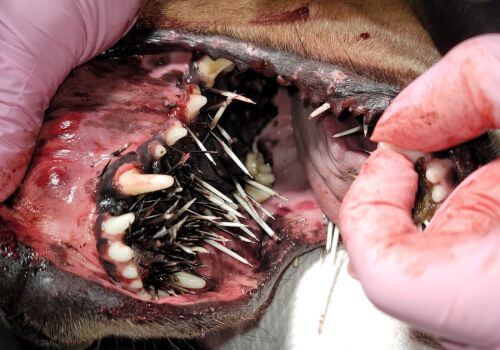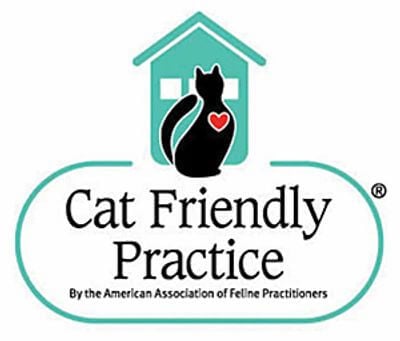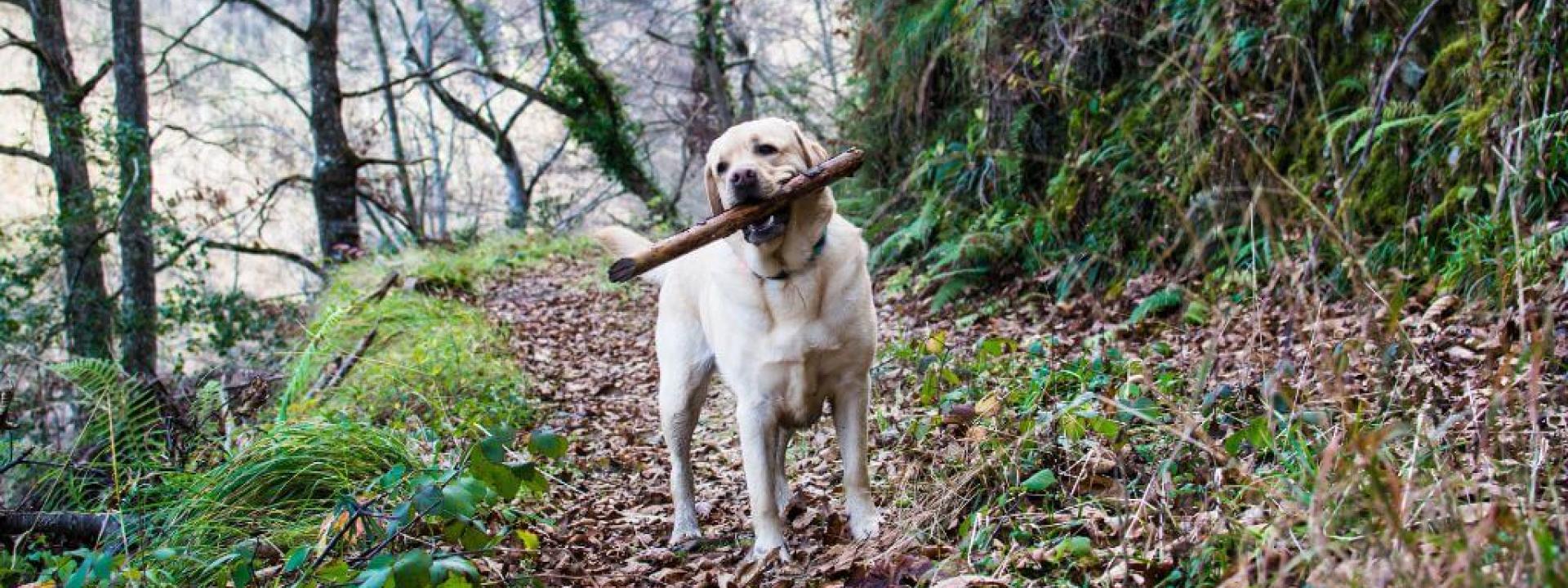While a dog having a run-in with a porcupine and coming home covered in quills may sound like a rare occurrence that the average owner doesn’t need to worry about, it’s unfortunately an accident that we see frequently at the clinic.
Over the years, we’ve treated dogs with quills that had punctured joints, pierced eyes, or worse, migrated internally. In one especially severe case, we examined a dog that came to us having difficulty breathing weeks after their owner had removed quills from its chest at home. A single broken quill had traveled deeper into the dog’s body, eventually causing a major infection that was caught during an MRI and required an advanced – and expensive – thoracic surgery at a specialty hospital.
With porcupine encounters being a real threat for any dog that spends time outside, it’s incredibly important for pet owners to know exactly what they’re dealing with when it comes to porcupine quills in dogs, including how they affect dogs, how they can best be removed, and how they can affect a dog’s long-term health. In this blog, I’ll be sharing some insights from the porcupine quills in dogs cases we’ve seen at Sugar River Animal Hospital and making recommendations on what owners should do if their dog is ever stuck by porcupine quills.
Dogs and Porcupine Quills: What You Need to Know
Before we get into the details of dealing with quills in a dog, let’s talk a little about the porcupines themselves and how dogs run into them in the first place.
Porcupines, which are the third-largest rodent in North America, are found in numerous regions throughout the United States, primarily in forested, mountainous, or brushy areas. However, due to their need for trees and ample vegetation, they are not commonly found in the Southeastern United States, in places like Florida, Georgia, and North and South Carolina.
These slow-moving, mostly nocturnal animals tend to keep to themselves, but that doesn't stop them from having the occasional run-in with other animals or people. When startled or in the presence of a perceived threat, porcupines will typically turn their backs and raise the sharp quills that cover their body. And yes, you heard that correctly – raise, not shoot. It's a common misconception that porcupines shoot their quills at threats, but they instead swing their tails or bodies at threats, and their quills easily pull away from their body, becoming lodged in their target.
Dogs can encounter porcupines during late-night walks, off-leash hikes, and even while exploring their own backyards if they live close enough to a suitable habitat for porcupines. Because porcupines cannot shoot or throw their quills, dogs that encounter porcupines from a distance can come away with no quills in their skin, but dogs who get up close to investigate or those who want to bark at or chase a porcupine aren't often as lucky.
How Porcupine Quills in Dogs Affect Their Health

One of the most common complications we see from porcupine encounters is lameness, especially when a dog has been quilled in one of its legs. When a cluster of quills becomes embedded in a limb, it can cause significant pain and inflammation, making it difficult or painful for the dog to walk. In many cases, this lameness improves with proper quill removal, rest, and pain management.
Will Porcupine Quills Kill a Dog?
Though it would be considered very rare for a porcupine encounter to directly result in death, it is not impossible. Under the right circumstances fatal injuries could be sustained, but pet owners should know that this would only be in the most extreme cases.
While the prognosis for a dog stuck by porcupine quills is generally good, not all cases are straightforward, which can lead owners to ask questions about the dangers of porcupine quills in dogs. Additional health complications beyond the initial puncture wounds can arise if the dog is not treated properly or if certain organs are punctured by deeply lodged quills. For example, if quills break off under the skin or go unnoticed, they can migrate deeper into tissue over time, leading to infections, abscesses, or damage to joints and nerves, making how owners respond to a porcupine encounter so important.
What to Do After Your Dog Has Been Stuck by Porcupine Quills
- Stay Calm and Keep Your Dog Calm – Panicking can make things worse, and getting your dog overly excited can cause them to drive the quills deeper into their skin, making for more painful removal. Be sure to speak gently and keep your dog – and yourself – as calm as possible while you assess your dog’s condition and the location and number of quills on their body.
- Limit Activity and Movement to Prevent Further Injury – Do not let your dog paw at their face or roll around because this again can lodge quills deeper in their skin. If it's safe, use a leash or towel to gently restrain your dog and keep them from moving around too much.
- Protect Sensitive Areas – If your dog has quills near the eyes, mouth, or chest, do your best to prevent them from rubbing or scratching at these areas until you reach a vet.
- Contact Your Veterinarian Immediately – Call your family veterinarian or nearest emergency clinic and calmly explain the situation. Let them know how many quills you can see and where they’re located so they can prepare for your arrival and get to work quickly.
How To Remove Porcupine Quills From a Dog
The safest and best way to get porcupine quills out of a dog is to visit your veterinarian and have them removed professionally. Removing porcupine quills from a dog – or really any other animal or human – needs to be done carefully and completely, as leftover or broken quills can lead to infections and other health complications later on.
To remove porcupine quills from a dog, a veterinarian will first use reversible sedation to sedate the dog and then begin carefully removing each quill, one by one, using hemostats. While some owners may be a little nervous about sedation, rest assured that it is completely safe for the dog and can help the veterinary team do a thorough job without the risk of the dog injuring themself further or biting anyone due to discomfort during the removal.
In more extreme cases where there are numerous quills in a dog’s skin, mouth, or eyes, general anesthesia may be used, but at Sugar River Animal Hospital, we only resort to this if the quill removal is very involved and injectable sedation is not going to be enough.
Can I Remove Porcupine Quills from My Dog on My Own?
The only time that it may be appropriate for an owner to remove quills on their own is if there are only one or two of them affecting the dog and they are not in the mouth or the eyes. However, owners may be putting themselves and their dogs at risk when they attempt quill removal on their own. In our hospital, we've seen owners get bitten by their dogs trying to remove quills on their own, which ends up doing more harm than good.

Owners should never try cutting the quills when attempting removal, despite what other people or other online resources say about cutting the quills resulting in “deflating” – that just isn’t true. Cutting the quills can actually make removal even more difficult and uncomfortable for the dog because once the structural integrity of the quill has been compromised, they are prone to splintering, which can create even more pieces of quill to remove or accidentally get left behind.
If you’re considering removing porcupine quills from your dog at home, here are a few reasons why I and other veterinary professionals would advise against it:
- Barbed quills are designed to move deeper into tissue, making removal difficult if you aren’t 100% sure of what you’re doing.
- Pulling them can cause quills to snap off under the skin, and you’ll need to seek veterinary attention anyway.
- Removal is painful and stressful for a dog without sedation, which you won’t have access to at home. Unsedated removal can be very painful and traumatic for dogs.
- Every single quill may not be easy to find, and some may be lodged in the mouth or under the skin and go unnoticed. If your dog tried to “taste” the porcupine, there is a good chance that there are numerous hard to spot quills in their mouth.
- Improper removal of porcupine quills in dogs can introduce bacteria to their wounds and cause abscesses and infections.
- Quills can migrate internally and travel to joints, eyes, lungs, or organs, causing serious damage.
- Vets can provide pain relief and antibiotics and ensure full recovery.
Will Porcupine Quills Work Themselves Out?
Unfortunately, once a dog has been quilled by a porcupine the quills will not come out on their own and will need to be removed manually. A porcupine quill is structured with tiny barbs on the end of each quill’s shaft. Once embedded in a dog’s skin, these barbs will force the quills deeper into soft tissue, as opposed to backing out and falling away on their own.
What to Expect After Quill Removal
Depending on how long the quills have been in the dog or which part of the body the quills are located in, we may recommend a course of antibiotics in addition to anti-inflammatory pain medication to keep your dog comfortable while they recover.
While the ordeal of your dog getting quilled by a porcupine can be stressful, the good news is that recovery is generally very quick. Many dogs are back to their normal selves within 24 hours and won’t require a follow-up visit unless they are still exhibiting signs of pain or infection in the following days.
Avoiding Unnecessary Run-Ins With Porcupines
The best way to prevent your dog from getting quilled is to keep them away from porcupines in the first place. If you have porcupines in your area, try to limit their off-leash activities in known habitats or where porcupines have been spotted. If you’ve previously spotted porcupines in your yard, keeping a close eye on your dog while they’re outside is highly recommended. Porcupines are great climbers and aren’t stopped by fences or small walls, so forgoing unsupervised time outside is a great way to prevent any porcupine-related accidents from befalling your dog.
Additionally, a mouth or face full of porcupine quills is not enough to deter dogs from being repeat offenders for porcupine quill removal at the vet’s office, and some studies have shown that some dogs will fall victim to porcupine encounters two, three, and even four times, making owners with watchful eyes imperative to preventing recurrent accidents.
However, sometimes vigilance isn’t always enough. Porcupine encounters can happen very quickly, and even the most well-trained or quick dog might not be able to get away unscathed, so knowing how to respond to these incidents can be invaluable knowledge for many owners.
If you have questions and you'd like to reach out to us, you can call us directly at (603) 287-1181, or you can email us at [email protected]. Don't forget to follow us on social media Facebook, Instagram.



